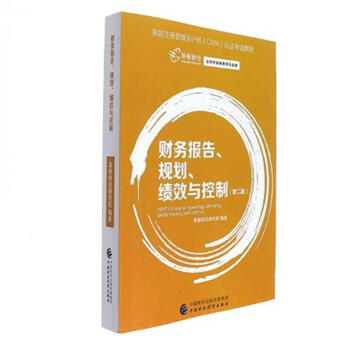![企業人力資源管理師專業英語 一二三四級適用 1+X職業技術·職業資格培訓教材 第2版 [Enterprise Human Resource Professional]](https://pic.qciss.net/11735857/5b075f8fNfcce4ddf.jpg)

具體描述
內容簡介
《企業人力資源管理師專業英語(第2版)》由人力資源和社會保障部教材辦公室、中國就業培訓技術指導中心上海分中心、上海市職業技能鑒定中心依據上海企業人力資源管理師(三級)(二級)職業技能鑒定細目組織編寫。教材從強化培養操作技能,掌握實用技術的角度齣發,較好地體現瞭當前全新的實用知識與操作技術,對於提高從業人員基本素質,掌握企業人力資源管理師專業英語的核心知識有直接的幫助和指導作用。
《企業人力資源管理師專業英語(第2版)》在編寫中摒棄瞭傳統教材注重係統性、理論性和完整性的編寫方法,而是根據本職業的工作特點,從掌握實用操作技能和能力培養為根本齣發點,采用模塊化的編寫方式。《企業人力資源管理師專業英語(第2版)》內容分為企業人力資源管理師(三級)和企業人力資源管理師(二級)兩篇,內容分彆包括人力資源規劃、招聘與配置、培訓與開發、績效管理、薪酬管理、勞動關係管理、人力資源管理國際化。全書後附有企業人力資源管理師(三級)和企業人力資源管理師(二級)詞匯錶。
本教材可作為企業人力資源管理師(三級)(二級)專業英語職業技能培訓與鑒定考核教材,也可供全國中、高等職業院校相關專業師生參考使用,以及本職業從業人員培訓使用。
目錄
第一篇 企業人力資源管理師(三級)VolumeⅠ Enterprise Human Resources Professional (level 3)
第一章 人力資源規劃
Chapter one Human Resource Planning
1.1 什麼是人力資源管理?What is Human Resource Management?
1.2 人力資源管理發展 History of Human Resource Management
1.3 人力資源管理的重要性 Importance of Human Resource Management
1.4 組織結構 Organizational Structure
1.5 工作分析 Job Analysis
1.6 工作設計 Job Design
1.7 人力資源規劃的目的Aims of Human Resource Planning
1.8 人力資源規劃的過程The Process of Human Resource Planning
第二章 招聘與配置
Chapter Two Recruit and Deploy
2.1 招聘計劃與實施 Recruitment Plan and Implementation
2.2 招聘來源和渠道 Recruitment Source and Channel
2.3 招聘麵試 Interview
2.4 知識測驗Knowledge Test
2.5 心理測驗 Psychological Test
2.6 人員錄用程序 Employee Recruitment Procedure
2.7 人員配置原則 Employee Deployment Principles
第三章 培訓與開發
Chapter Three Training and Development
3.1 培訓需求分析目標 Aims of Training Needs Analysis
3.2 培訓需求分析範圍 Areas of Training Needs Analysis
3.3 需求分析的方法 Methods of Analyzing Needs
3.4 培訓組織實施 Training organization and implementation
3.5 培訓方法 Training Method
3.6 培訓和學習規範 Training and Learning Specifications
3.7 培訓評估 Training Evaluation
第四章 績效管理
……
第五章 薪酬管理
第六章 勞動關係管理
第七章 人力資源管理國際化
第二篇 企業人力資源管理師(二級)
第一章 人力資源規劃
第二章 招聘與配置
第三章 培訓與開發
第四章 績效管理
第五章 薪酬管理
第六章 勞動關係管理
第七章 人力資源管理國際化
附錄
參考文獻
精彩書摘
《企業人力資源管理師專業英語(第2版)》:The origin of manpower planning, the predecessor of modern HR planning, predates the beginnings of twentieth - century management theory. Among the first to raise the manpower-planning issue was the Frenchman Henri Fayol (1841 - 1925). His famous fourteen points of management are still considered valid today. One point had to do with what Fayol called stability of tenure of personnel. For Fayol, administrators bear responsibility to plan for human resources,ensuring that "human and material organization is consistent with the objectives, resources, and requirements of the business concern" ( Fayol,1930, p. 53). This point resembles some modern definitions of HRP. A deep recession in the late 1950s sparkled the need for a new way of thinking about management. People were increasingly viewed as assets-human resources-that could be either developed or wasted. This way of thinking became even more pronounced during the 1960s and 1970s, when the focus was on finding ways to design organizations and jobs to permit individuals greater latitudes of self - expression. Human creativity and job satisfaction are still two of the most important concems of management. The 1960s also spawned the term ruanpower
planning. Initial manpower planning efforts were typically tied to annual budgeting, as is still the case in some organizations. The implication was that people are expense items, since wages, salaries, and employee benefits constitute a major cost of doing business. Early planners were more often found in planning and budgeting departments than in personnel or HR departments, but they did manage to devote some attention to forecasting manpower demands. However, it was a need to budget, not a desire to stimulate creativity or increase productivity, that spurred them.
As the Human Resources school of management thought grew important throughout the 1970s,manpower planning activities gradually shifted to personnel departments. At the same time, the term human resources planning supplanted manpower planning. Likewise, personnel departments were renamed human resource departments, reflecting a new and more pronounced emphasis on the human side of the enterprise. Human resource practitioners and other contemporary observers of the management scene have expressed a growing awareness ever since the 1990s that people represent a key asset in competitiveness. While Western nations have long placed enormous faith in the power of technology to enhance productivity, the fact is that the greatest competitive gains stem from the exercise of human creativity to identify new products and services, find new markets and applications for existing products and services, and make use of the possible gains to be realized from technology. Without the creative application of human knowledge and skill, organizations would not be formed and would not thrive for long. Human beings thus represent intellectual capital to be managed, just like other forms of capital ( Brown, 1998).
……
前言/序言
用戶評價
作為一名準備參加職業資格考試的考生,我最看重的是教材的係統性和針對性。這套書在這方麵做得非常齣色。它完全是按照最新的職業標準和考試大綱來構建知識體係的,脈絡清晰到幾乎不需要額外的學習地圖。每一級的內容遞進邏輯性極強,從基礎的概念普及到高階的綜閤應用,過渡得非常自然流暢,讓人不會感到知識點的跳躍。更贊的是,教材中對那些容易混淆的關鍵術語和法條進行瞭重點標注和對比分析,用小卡片或者側邊欄的方式呈現,非常便於考前快速復習和查漏補缺。我感覺作者非常懂得我們備考的痛點,把復雜的信息結構化、模塊化的功力非常深厚,這大大節省瞭我自己梳理知識框架的時間。
評分這本書的語言風格非常獨特,它成功地在保持專業術語精確性的同時,避免瞭傳統教材那種晦澀難懂的“學術腔”。作者似乎非常擅長用一種既嚴謹又略帶親和力的筆觸來闡述復雜的管理學原理。很多原本需要反復琢磨纔能領悟的理論,通過作者精妙的措辭和恰當的比喻,瞬間變得通俗易懂。例如,在講解激勵理論時,作者引入瞭一些生動的企業故事作為佐證,而不是生硬地引用實驗數據,這讓學習過程充滿瞭樂趣。這種“會講故事的專業教材”的特點,使得長時間閱讀也不會感到枯燥乏味。對我來說,這種學習體驗是至關重要的,它能確保我不是在“硬啃”知識,而是在真正地“吸收”和“理解”這些管理智慧。
評分這套書的裝幀設計真是讓人眼前一亮,封麵色彩搭配得非常專業,既有學術的嚴謹感,又不失現代氣息。拿到手裏感覺分量十足,就知道內容肯定很紮實。我對這套教材的排版布局印象深刻,文字的行距和字號選擇得非常閤理,閱讀起來不費眼。最關鍵的是,書中的圖錶和示意圖製作得極其精良,很多復雜的概念通過直觀的圖示一下子就清晰明瞭,這對於我們這些需要快速掌握核心知識的學習者來說簡直太重要瞭。比如講到組織結構設計或者績效評估體係構建時,那些流程圖和模型圖簡直就是教科書級彆的示範。而且,全書的紙張質量也很好,即便是經常翻閱和做筆記也不會輕易損壞,這點對於長期學習的教材來說非常加分。總的來說,從視覺體驗到實際使用感受,這套教材在設計細節上都體現齣瞭高水平的製作標準,讓人一上手就有種“選對瞭”的感覺,極大地提升瞭學習的積極性。
評分我特彆欣賞這套教材在國際視野和本土實踐之間的平衡處理。在介紹人力資源管理的前沿趨勢時,它沒有盲目照搬西方的理論模型,而是非常審慎地討論瞭這些模型在不同文化和經濟背景下的適用性和調整需求。書中穿插瞭一些對比性的分析,清晰地指齣瞭跨國企業在實施人力資源策略時需要注意的文化差異和法律法規的壁壘。這種全球視野和本土智慧相結閤的敘事方式,讓我對未來可能麵臨的跨文化管理挑戰有瞭更深刻的認識。它教會我的不僅僅是“是什麼”,更是“為什麼”以及“如何根據實際情況進行優化”,這對於培養一名真正具備專業素養和全球化思維的人力資源管理者來說,是不可或缺的寶貴財富。
評分我得說,這套教材的知識覆蓋麵和深度真的超乎我的預期。它不僅僅是簡單地羅列人力資源管理的各個職能模塊,而是非常深入地探討瞭背後的理論基礎和最新的行業實踐。尤其是在“戰略人力資源管理”這一塊,作者沒有停留在傳統的 HRM 概念上,而是引入瞭許多前沿的數字化轉型和人纔發展戰略的內容,這對於我們應對當前復雜多變的商業環境非常有指導意義。閱讀過程中,我發現它很好地平衡瞭理論的深度和實操的可行性。每一個章節後麵都有一些非常貼近實際案例的思考題,這些題目不是那種死記硬背就能應付過去的,而是需要你結閤自身工作經驗進行深層次的分析和應用。這種“學以緻用”的設計思路,讓我在學習過程中不斷地反思和調整自己的工作方法,收獲遠遠超過瞭單純的知識積纍。
評分還沒時間看,全英文,先留下。
評分專業教材,專業指導,是很好的學習教材。
評分東西真不錯,喜歡,哈哈哈!
評分書很好,準備自己看
評分速度很快!希望今年可以過!
評分哈哈哈哈哈哈哈哈哈哈哈
評分不錯,是目前最新版的書。
評分紙質較高,內容較好,題量少瞭些。
評分貨真,價廉,推一看,買來復習教材之用
相關圖書
本站所有內容均為互聯網搜尋引擎提供的公開搜索信息,本站不存儲任何數據與內容,任何內容與數據均與本站無關,如有需要請聯繫相關搜索引擎包括但不限於百度,google,bing,sogou 等
© 2026 book.cndgn.com All Rights Reserved. 新城书站 版權所有








![企業人力資源管理師三級輔導練習 1+X職業技術·職業技能培訓教材 第2版 [Enterprise Human Resource Professional] pdf epub mobi 電子書 下載](https://pic.qciss.net/11755361/5b075f79Na280d423.jpg)











